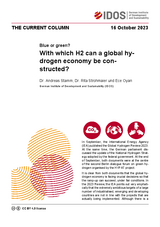Blue or green?
With which H2 can a global hydrogen economy be constructed?
Stamm, Andreas / Rita Strohmaier / Ece OyanThe Current Column (2023)
Bonn: German Institute of Development and Sustainability (IDOS), The Current Column of 16 October 2023
In September, the International Energy Agency (IEA) published the Global Hydrogen Review 2023. At the same time, the German parliament discussed the update of the National Hydrogen Strategy adopted by the federal government. At the end of September, both documents were at the centre of the second Berlin dialogue forum on green hydrogen organised by the HYPAT project.
It is clear from both documents that the global hydrogen economy is facing crucial decisions so that the ramp-up can succeed, under fair conditions. In the 2023 Review, the IEA points out very emphatically that the extremely ambitious targets of a large number of industrialised, emerging and developing countries are not in line with the projects that are actually being implemented. Although there is a long pipeline of projects for the production of climate-friendly hydrogen, final investment decisions have only been made for 4% of them. Meanwhile, Germany’s hydrogen strategy raises its own ambitions for market ramp-up by doubling the target for indigenous production while acknowledging the need for large-scale imports from different regions of the world.
Both papers discuss the use of hydrogen (H2) based on fossil fuels with capture, utilisation and storage of the resulting CO2 (Carbon Capture Utilisation and Storage, CCUS) as an intermediate technology on the way to completely emission-free, “green” H2. Can “blue” H2 solve the current blockage in the market ramp-up, and what consequences would accelerated use have for developing countries? Three arguments suggest that blue H2 can lead more quickly to the replacement of the use of oil, gas and coal with climate-friendly H2 in heavy industry, for example.
Firstly, the costs: According to the IEA, the cost of blue H2 in 2021 was US$ 1.50 – 3.60 per kg, and for green H2 produced by electrolysis it was US$ 3.40 – 12 per kg. Although scenarios assume that cost parity between the two “colours” will be achieved by about 2030, this is highly uncertain. Secondly, the creation and maintenance of factories for the production of blue H2 in many countries can rely on established plant engineering and construction, as components are often used that have been used in other industries for decades. Thirdly, something which is relevant for Germany, blue H2 can be sourced on a large scale from the European periphery or neighbourhood (Norway, UK, Middle East) and in the medium term can be transported by pipeline.
Whether greater consideration of blue H2 is good for climate policy or not can only be thought about and evaluated in terms of results. If we succeed in massively accelerating the hydrogen ramp-up and switching to green H2 in the medium term, the net result may be good. However, blue H2 is not emission-free. Methane emissions at the upper end of the chain, i.e. during the extraction and transport of natural gas, are particularly problematic. There is the risk of a “lock-in”: once a functioning blue hydrogen and CCUS industry has emerged, it will be difficult to switch to green H2, which is the first choice with respect to climate policy.
Germany should develop strategies at an early stage to pursue the goal of a green, not blue, hydrogen economy. Thus, future hydrogen partnerships with third countries should prioritise electrolytically produced hydrogen throughout. Large consumers of climate-friendly H2 should show their willingness to bear part of the additional costs of green compared to blue H2 in the transition phase, as it is also in their interest to secure a hydrogen supply independent of fossil fuels in the long term. This can at least be expected from those companies whose conversion to H2-suitable technologies is massively subsidised by the public sector, for example currently the steel manufacturer Thyssen-Krupp. It should be examined whether the remaining part of the price differential – in an internationally coordinated effort – can be bridged by public funds.
Developing countries that can only produce green H2 and are dependent on transport by ship could be among the losers in the short term, as they cannot compete in price terms with blue H2, which will also be transported by pipeline in the medium term. For them, the domestic use of green H2 will become an important prospect. Germany and Europe should also offer support for this, for example through technology transfer and scientific cooperation and with the aim of supporting the energy transition in developing countries.




